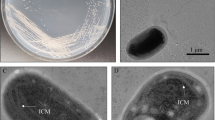Abstract
A syntrophic consortium was enriched in a basal medium containing cinnamate as the carbon and energy source. It was found to consist of three morphologically distinct microbes, viz., a short, rod-shaped, non-motile bacterium with distinctly pointed ends, Papillibacter cinnamivorans; a rod-shaped, motile bacterium with rounded ends, Syntrophus sp.; and a methanoarchaeon, Methanobacterium sp. This methanogen was then replaced by a collection strain of Methanobacterium formicicum. A syntrophic interdependency of the three partners of the consortium was observed during growth on cinnamate. In the presence of bromoethanesulfonic acid (BESA), cinnamate was transformed to benzoate, whereas under methanogenic conditions without BESA, cinnamate was first transformed to benzoate via β-oxidation and subsequently completely degraded into acetate, CH4, and CO2. Papillibacter cinnamivorans was responsible for benzoate production from cinnamate, whereas a syntrophic association between Syntrophus sp. and the methanogen degraded benzoate to acetate, CH4, and CO2. A new anaerobic degradation pathway of cinnamate into benzoate via β-oxidation by a pure culture of P. cinnamivorans is proposed.
Similar content being viewed by others
Author information
Authors and Affiliations
Additional information
Received: 27 December 2001 / Accepted: 28 March 2002
Rights and permissions
About this article
Cite this article
Defnoun, S., Ambrosio, M., Garcia, JL. et al. Degradation of Cinnamate via β-Oxidation to Benzoate by a Defined, Syntrophic Consortium of Anaerobic Bacteria. Curr Microbiol 46, 0047–0052 (2003). https://doi.org/10.1007/s00284-002-3759-9
Issue Date:
DOI: https://doi.org/10.1007/s00284-002-3759-9




